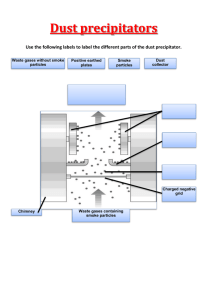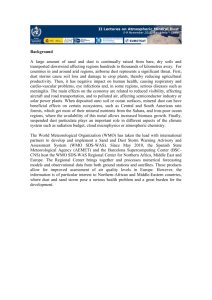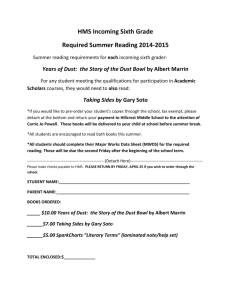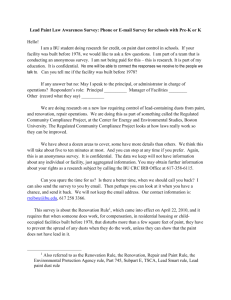Clearance Report - National Center for Healthy Housing
advertisement
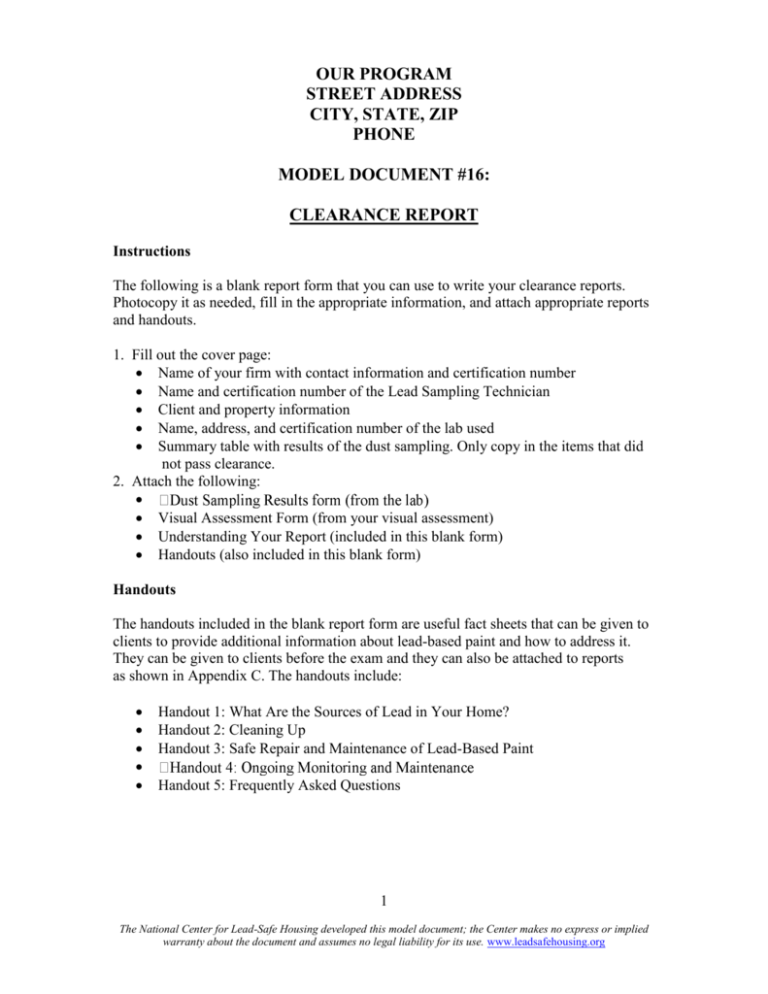
OUR PROGRAM STREET ADDRESS CITY, STATE, ZIP PHONE MODEL DOCUMENT #16: CLEARANCE REPORT Instructions The following is a blank report form that you can use to write your clearance reports. Photocopy it as needed, fill in the appropriate information, and attach appropriate reports and handouts. 1. Fill out the cover page: Name of your firm with contact information and certification number Name and certification number of the Lead Sampling Technician Client and property information Name, address, and certification number of the lab used Summary table with results of the dust sampling. Only copy in the items that did not pass clearance. 2. Attach the following: Visual Assessment Form (from your visual assessment) Understanding Your Report (included in this blank form) Handouts (also included in this blank form) Handouts The handouts included in the blank report form are useful fact sheets that can be given to clients to provide additional information about lead-based paint and how to address it. They can be given to clients before the exam and they can also be attached to reports as shown in Appendix C. The handouts include: Handout 1: What Are the Sources of Lead in Your Home? Handout 2: Cleaning Up Handout 3: Safe Repair and Maintenance of Lead-Based Paint Handout 5: Frequently Asked Questions 1 The National Center for Lead-Safe Housing developed this model document; the Center makes no express or implied warranty about the document and assumes no legal liability for its use. www.leadsafehousing.org CLEARANCE EXAMINATION REPORT Clearance Examiner: __________________________ Check one: Sampling Technician _____ Risk Assessor _____ Inspector _____ Company: _________________________________________ Address: ____________________________________________________ City, State Zip: ____________________________________________________ Phone/Fax Number: ____________________________________________________ Firm certification number (if any): ___________ Date of Examination: Lead Sampling Technician: Certification number: Property address: Apartment/Unit #: Client name: Client address: Laboratory: Address: Telephone number: NLLAP number: SUMMARY RESULTS: DUST SAMPLING Lead-contaminated dust was found in the following areas: Location Surface Level of lead in dust: µg /ft² Signature: _________________________ Date: ________ 2 The National Center for Lead-Safe Housing developed this model document; the Center makes no express or implied warranty about the document and assumes no legal liability for its use. www.leadsafehousing.org VISUAL ASSESSMENT RESULTS Date of Examination: Clearance Examiner: Client: Property address: Location Description of visible areas of dust, paint chips, painted debris, and deteriorated paint. (Note specific location within the room: walls, ceiling, floors, doors, windows, trim, cabinets, etc.) Entry Area Living Room Dining Room Kitchen Common Area Bedroom #1 Bedroom #2 Bath #1 Exterior (Attach Copy of Lab Report) 3 The National Center for Lead-Safe Housing developed this model document; the Center makes no express or implied warranty about the document and assumes no legal liability for its use. www.leadsafehousing.org To the Client and/or Occupant: Understanding Your Report 1. The Summary Results section lists all of the areas that failed the clearance examination. The entire area represented by the sample needs to be re-cleaned and then re-tested to see if the cleaning removed the contaminated dust. Written information on proper cleaning, monitoring, addressing sources of lead in the home, and safe repair of paint are included with this report. Further information can be obtained by contacting the National Lead Information Center Clearinghouse at 1800-424-Lead (1-800-424-5323). You may consider hiring a risk assessor to evaluate lead hazards in your home and prepare a lead hazard control plan. Risk assessors in your area can be located through the Lead Listing at 1-888-Leadlist (1888-532-3547). 2. The laboratory result forms attached to the report list all of the areas sampled inside and outside the dwelling and the laboratory analysis results for each sample. 3. The results of dust wipe samples are presented in micrograms per square foot (µg/ft²); soil samples are presented in micrograms per gram (µg/g). 4. Areas that failed the clearance examination showed lead levels in dust or soil at or above EPA or HUD standards, or state standards. The federal standards are: Federal (EPA) Standards for Lead in Dust Per January 5, 2001 final rule, effective March 6, 2001 Floors: 40 µg/ft² Interior window sill (stool): 250 µg/ft² Window trough: 400 µg/ft² Until March 6, 2001, EPA guidance standards were: Floors: 100 µg/ft² Interior window sill (stool): 500 µg/ft² Window trough: 800 µg/ft² Until March 6, 2001, HUD Standards:* Floors: 40 µg/ft² Interior window sill (stool): 250 µg/ft² Window trough: 800 µg/ft² * Apply only to dwellings that receive funding from the U.S. Department of Housing and Urban Development (HUD). 4 The National Center for Lead-Safe Housing developed this model document; the Center makes no express or implied warranty about the document and assumes no legal liability for its use. www.leadsafehousing.org Handout #1 What Are the Sources of Lead in Your Home? There are four major sources of lead that can pose a health hazard to people in and around the home. The sources are: 1. Lead-based paint. Lead-based paint can be found in housing built before 1978. It can be a hazard, especially if it deteriorates or, if it is disturbed during maintenance or normal wear and tear. If lead-based paint is peeling, chipping, chalking or cracking, it will create lead-contaminated dust that poisons children through normal hand-to-mouth activity. Children may also eat paint chips or chew on painted surfaces that are accessible to them, resulting in poisoning. Even leadbased paint that appears to be in good condition can be a problem if it is on surfaces that get a lot of wear and tear, such as door jambs and window tracks. It is important to remove the causes of deteriorating paint such as water leaks. Repair areas where lead paint is deteriorating by repainting using a good latex paint or lead sealer. (See Handout #3 on safe paint repair). 2. Lead-contaminated dust. Lead-contaminated dust is created when lead-based paint is sanded or scraped during maintenance or repair, or just through every day wear and tear. When maintenance or renovation takes place, the dust from these operations settles on surfaces such as floors, countertops, window sills and furniture. If the paint being worked on contains lead, the lead is deposited on surfaces as dust. Window tracks and door jambs can be another source of leadcontaminated dust. If these components rub during normal opening and closing, lead-contaminated dust can be created and deposited on surfaces throughout the home. Lead from work done on house exteriors can be tracked into the home, becoming an additional source of lead dust. After routine home maintenance or remodeling renovation and painting, the home should be thoroughly cleaned to remove any dust that may be left behind because it may contain lead. Lead dust sampling should then be performed to verify that the cleaning was effective. 3. Lead-contaminated soil. Soil can become contaminated when exterior leadbased deteriorates and gets into the soil. Homes near certain industries such as smelters or battery manufacturers may have lead into the soil as a result of these operations. Past use of leaded gasoline has also left lead deposits in our nation’s soil. Playgrounds and gardens should not be placed in areas where the soil is contaminated with lead. Soil can be tracked into the home so it is important for workers to clean shoes or remove them before entering the home. 4. Lead-contaminated drinking water. Drinking water can be contaminated with lead, regardless of the water’s source. Many faucets in homes and on store shelves contain leaded components that can leach lead into the water. Leaded solder in household piping and leaded components in well pumps have been in use for many years, and continue to leach lead into the drinking water of thousands of 5 The National Center for Lead-Safe Housing developed this model document; the Center makes no express or implied warranty about the document and assumes no legal liability for its use. www.leadsafehousing.org homes even today. Many public water delivery systems still have old lead piping through which the water must pass before it reaches the home. Water with a high pH has a tendency to leach more lead than water with a neutral pH, and warm water leaches more lead than cold. Allow cold water to run before drinking. The following are sources of information about lead-based paint in your home: National Lead Information Center (NLIC) – 1-800-424-LEAD (1-800-424-5323). NLIC is a clearinghouse for information on lead. They provide copies of pamphlets, reports, and other resources. Safe Drinking Water Hotline – 1-800-426-4791. This hotline provides information and assistance to the public on safe drinking water. Handout #2 CLEANING UP It is very important to use proper cleanup procedures at the end of any remodeling, repainting, or maintenance job. Dust and paint chips left behind at the end of the job may contain lead and may endanger children. Have dust wipe samples collected at the end of the job to be sure that it is safe for children to return. Cleaning the Work Area 1. Pick Up Work Area Pick up large chips with damp paper towel. Mist then push dust into dust pan. 2. Pick Up Protective Sheeting Clean off protective sheeting. Fold dirty side inward (dirty side to dirty side). Dispose of protective sheeting at the end of each job. Protective sheeting may be used again within the same work area if it has not already been folded. 3. Vacuum HEPA vacuum all horizontal surfaces—slowly. Vacuum all ledges, sills, stools, molding tops, dusty surfaces, etc. Vacuum floor under work area. Use vacuum corner tools in corners, cracks of trim, and between floor boards. Vacuum floor with floor brush and carpet with a carpet tool. Important: Vacuum carpet very slowly. 4. Mist and Scrub Wet rag with detergent then wring out. Mist surface or rag as you clean. Lead needs scrubbing, not just wiping. 5. Rinse Rag 6 The National Center for Lead-Safe Housing developed this model document; the Center makes no express or implied warranty about the document and assumes no legal liability for its use. www.leadsafehousing.org Squeeze rag into empty side of split bucket. Rinse out rag. Squeeze into empty side. Repeat as needed. Change rinse water often. Use paper towels first if surfaces are very dirty. Replace rag when it looks dirty. Recommendation: Make a final pass with a HEPA vacuum. Cleaning Floors 1. Mist and Scrub At start of cleaning, soak mop in detergent water then mist small area with detergent before mopping. out and rinse again. Mop small areas at a time. 2. Rinse Repeat above process using clean water rather than detergent. When cleaning up a work site, use a new mop head for rinse stage. Recommendation: Make a final pass with a HEPA vacuum. Handout #3 Safe Repair and Maintenance of Lead-Based Paint Repairing, removing or maintaining lead-based paint improperly can spread leadcontaminated dust throughout the home. It is very important to use safe work methods when working on surfaces that may contain lead-based paint. 1. Use the proper equipment. You will need the proper tools and supplies to do the job correctly. In addition to tools such as scrapers and putty knives, it is important to have: A HEPA vacuum (a vacuum equipped with a very fine filter capable of filtering very small particles of lead); double sided mop bucket and mop; a good household detergent; ample disposable paper towels or rags; plastic sheeting; tack cloth; disposal waste bags; wet sanding blocks; and misting bottle filled with water. 2. Set up the work area property. The key is to contain the dust and debris created by the work. Create a barrier between the work area and the rest of the house. Use plastic sheeting over the doorways to seal off the area and protect the rest of the house from exposure. Work over a plastic drop cloth (never use cloth) to catch any debris created as a result of paint removal. Wear disposable shoe covers and remove them before exiting the work area, or step onto a tack cloth to remove paint chips and dust from the soles of shoes. Keep doors and windows closed to prevent dust from blowing and close off vents to central air or heating systems to avoid spreading dust to other parts of the house. Remove all furniture, or cover tightly with plastic sheeting. Do not allow children or pregnant women into the work area. 7 The National Center for Lead-Safe Housing developed this model document; the Center makes no express or implied warranty about the document and assumes no legal liability for its use. www.leadsafehousing.org 3. Safe work practices. Never remove lead-based paint by dry-sanding, dry scraping or burning. Use power sanders, grinders, and planers only with a HEPA exhaust attachment. Using your misting bottle, wet the painted surface before sanding with a wet sanding block, or scraping. Be sure to work over a plastic drop cloth to catch any large particles. Do not eat, drink, smoke or chew gum while working. 4. Clean as you work. Be sure to wet clean the areas you are working on as you go along. Though it will be necessary to clean the entire house at the end of the project, it is important to clean as you work in order to keep lead-contaminated dust from spreading. Clean using a good household detergent. Rinse your cleaning utensils in clean water. 5. Proper disposal. When the work is done, mist the plastic sheeting with water to keep down the dust. Roll the plastic sheet up, keeping the dirty side in. Pick up any paint chips or other debris that may have fallen elsewhere. Be sure to place all disposable items used in the repair and clean up into plastic waste bags. The bags must be tightly sealed and properly can be disposed of with the household trash*. Once the bags are sealed, do not reopen them. 6. Have dust sampling done. You should have dust sampling done after all renovations, painting, maintenance and cleaning activities. The results of this test will tell you if your work practices and final cleaning have been effective at removing lead-contaminated dust. Since lead dust levels in the home may change over time, it is strongly suggested that you perform dust testing periodically to help safeguard your family. If lead-contaminated dust levels begin to rise, reinspect the home for deteriorating paint, repair where necessary repeating the steps outlined in this fact sheet, and be sure to wet clean thoroughly. * Check with your State lead program to make sure that there is no regulation prohibiting this. Handout #4 Ongoing Monitoring and Maintenance Take the following steps to make sure that paint is not deteriorating in your home and creating lead-contaminated dust and paint chips. This will help prevent children from being lead poisoned. 1. Regularly Check Repairs for Deterioration, Paint Chips, and Dust Property owners should regularly monitor painted surfaces where maintenance or improvements were performed. Check to see if: New evidence of deterioration or paint failure is present. The cause of the problem was corrected. 8 The National Center for Lead-Safe Housing developed this model document; the Center makes no express or implied warranty about the document and assumes no legal liability for its use. www.leadsafehousing.org Lead dust hazards are present. Important: This can only be determined by dust wipe sampling. 2. Maintain Surfaces and Thoroughly Clean Perform repairs, as needed, to maintain surfaces in a smooth and cleanable condition using safe work methods; and Clean the area thoroughly using safe cleaning practices. 3. Methods of Monitoring Follow these steps to check your work: Conduct Visual Check. Look for deterioration, paint failure, dust and paint chips. Test for Lead Dust. Have dust wipe samples taken to check for dust that may be contaminated with lead. A test is needed to determine when dust contains harmful amounts of lead. 4. When to Monitor? Annually. Perform a visual check of past repairs and improvements involving painted surfaces. During Unit Turnover or Routine Maintenance. Perform a visual check of past repairs and improvements involving painted surfaces. Every Two Years. Get a dust wipe done at least every two years. This type of test is strongly recommended when a young child or pregnant women lives in the home. 5. Why is it Important to Monitor and Maintain Work? Monitoring and maintenance helps: Plan and implement maintenance tasks Protect occupants and neighbors, particularly children, from lead exposure Give owner, contractors, and residents a record of the condition of the unit Handout #5: Frequently Asked Questions about Clearance Examinations Question 1. If lead-contaminated dust was found to be below Federal standards, does that mean that my property is “lead-free?” 2. The results indicated that lead was undetectable, is my property “lead-free?” 3. Where did the dust come from? Answer No. Lead-based paint may be present. The lower levels can still be dangerous, and the sources of dust may still be present. Because the clearance tested for levels of lead in dust at the time samples were taken, the levels could change over time. No, only paint testing can determine for certain whether a property is free of lead-based paint. A clearance test only tests for the presence of lead in dust at the time of testing. Lead in dust could exist later. Dust can come from many sources including renovation or maintenance work, lack of regular cleaning, deteriorated painted surfaces, or sources from outside the property. The test does not evaluate the quality or effectiveness of renovation or maintenance or the state of existing 9 The National Center for Lead-Safe Housing developed this model document; the Center makes no express or implied warranty about the document and assumes no legal liability for its use. www.leadsafehousing.org 4. What kind of cleaning will remove the lead dust? 5. Who is responsible for removing the dust? 6. The clearance report shows lead in dust above the Federal standards. What should I do? 7. What should I do to monitor the lead-based paint hazards? 8. Should I keep the report? For how long? building conditions. Only a certified/licensed risk assessor is qualified to determine the source of lead dust. If the clearance test occurred right after maintenance or renovation work was done, a thorough re-cleaning and second clearance test may be the most prudent course of action. See the advice provided as Handout #2, “Cleaning Up.” The property owner is ultimately responsible. If the owner has an agreement with a contractor who just performed work, the contractor may have to perform another cleaning and have the clearance test conducted again. The answer to this question depends on whether clearance was performed for HUD-related work or not. For non-HUD projects: There are no regulatory requirements to respond to lead-contaminated dust. However, a proper re-cleaning is recommended to remove the lead-contaminated dust and make the home safe for occupancy. A second clearance test after re-cleaning is recommended. A property owner must disclose to future occupants or potential homebuyers the results of the clearance testing. If a second clearance test shows levels below the standards, this result should also be disclosed to show that you have dealt with the lead hazard. For HUD-related clearance: Proper re-cleaning followed by another clearance examination is required. The unit must be re-cleaned and clearance performed until the clearance shows no lead dust above the HUD standards. If the clearance examination identifies lead-contaminated dust, owners of rental properties must inform the occupants of the results of the clearance examinations even if the lead dust was successfully removed. It is important that occupants be aware that there has been lead-contaminated dust in the property because it could occur again in the future. If paint is disturbed in the future, follow lead-safe work practices and conduct clearance again. If a child under six or a pregnant woman moves into the unit, consider having dust wipe samples collected and tested for lead-contaminated dust. If you want to know more about lead hazards or lead-based paint in the unit, consider hiring a certified risk assessor or lead paint inspector. The report should be kept as a reference in case issues arise later. For example, you may need it to comply with Federal disclosure requirements if you rent or sell your home. For work on HUD projects, the report documents whether a unit meets HUD requirements for clearance after rehabilitation or maintenance. In any case, it is most prudent to plan to keep the report indefinitely. 10 The National Center for Lead-Safe Housing developed this model document; the Center makes no express or implied warranty about the document and assumes no legal liability for its use. www.leadsafehousing.org
![[Agency] recognizes the hazards of lead](http://s3.studylib.net/store/data/007301017_1-adfa0391c2b089b3fd379ee34c4ce940-300x300.png)

